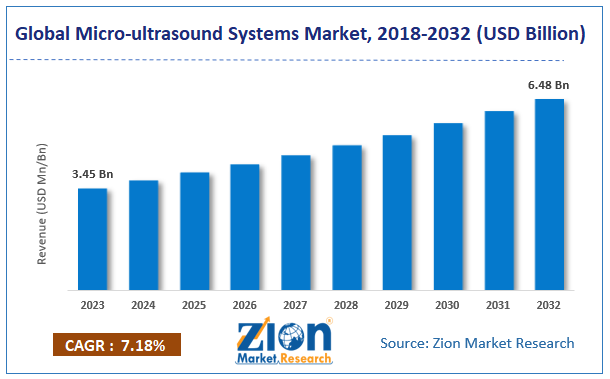Micro-ultrasound Systems Market Size, Share, Analysis & Forecast 2032
The micro-ultrasound systems market involves devices that use high-frequency ultrasound technology to provide detailed imaging for medical diagnostics. These systems are designed to offer high-resolution images and are often used for various applications, including obstetrics, gynecology, cardiology, and general imaging. Micro-ultrasound systems are distinguished by their ability to deliver higher image quality compared to traditional ultrasound systems, thanks to their higher frequency and advanced technology.

Get a Free Sample : https://www.zionmarketresearch.com/sample/micro-ultrasound-systems-market
Key Market Insights
Market Growth Drivers:
- Technological Advancements: Continuous advancements in micro-ultrasound technology, such as higher resolution and improved image quality, are driving market growth. Innovations like 3D/4D imaging and real-time imaging capabilities enhance diagnostic accuracy.
- Rising Demand for Early Diagnosis: The increasing emphasis on early disease detection and prevention, particularly in areas like oncology and cardiology, is fueling demand for high-resolution imaging systems.
- Growing Applications in Obstetrics and Gynecology: The use of micro-ultrasound systems in obstetrics and gynecology for detailed fetal imaging and monitoring is contributing to market growth.
- Increased Adoption of Point-of-Care Ultrasound: The trend towards point-of-care ultrasound solutions, which provide rapid and accessible imaging in clinical settings, is boosting demand for portable and high-resolution micro-ultrasound systems.
- Expansion of Healthcare Infrastructure: Investments in healthcare infrastructure and increasing healthcare spending, particularly in emerging markets, are driving the adoption of advanced imaging technologies.
Market Segmentation:
- By Product Type:
- Portable Micro-Ultrasound Systems: Compact, portable devices that can be used in various clinical settings, including bedside imaging and emergency situations.
- Stationary Micro-Ultrasound Systems: Larger, more advanced systems typically found in imaging centers and hospitals, offering high-resolution imaging for detailed diagnostics.
- By Application:
- Obstetrics and Gynecology: Used for detailed fetal imaging, monitoring, and assessment of gynecological conditions.
- Cardiology: Applied in cardiology for assessing heart conditions, including valve defects and congenital heart diseases.
- Oncology: Utilized for tumor detection, monitoring, and characterization in oncology.
- General Imaging: Includes applications in abdominal imaging, musculoskeletal imaging, and other general diagnostic purposes.
- Others: Includes specialized applications such as urology and emergency medicine.
- By End-User:
- Hospitals: Major users of micro-ultrasound systems for a wide range of diagnostic and monitoring purposes.
- Diagnostic Imaging Centers: Specialized centers that utilize advanced imaging technologies for detailed diagnostics.
- Clinics and Physician Offices: Growing adoption of micro-ultrasound systems in smaller clinical settings for point-of-care imaging.
- Research and Academic Institutions: Use of micro-ultrasound systems for research and development purposes.
- By Product Type:
Geographical Insights:
- North America: The largest market, driven by advanced healthcare infrastructure, high adoption rates of new technologies, and strong investment in medical imaging research and development.
- Europe: Significant growth due to advanced healthcare systems, increasing demand for high-resolution imaging, and supportive regulatory environments.
- Asia-Pacific: Expected to experience rapid growth due to rising healthcare investments, increasing awareness of advanced imaging technologies, and expanding healthcare infrastructure.
- Latin America and Middle East & Africa: Emerging markets with growing healthcare needs and increasing access to advanced imaging technologies.
Challenges:
- High Cost of Equipment: The high cost of micro-ultrasound systems can be a barrier to adoption, particularly in cost-sensitive regions and smaller healthcare settings.
- Technical Expertise Required: High-resolution imaging systems require specialized training and expertise, which can limit their use in certain settings.
- Regulatory and Compliance Issues: Navigating complex regulatory requirements and ensuring compliance with medical device standards can impact market growth.
- Maintenance and Upgrades: The need for regular maintenance and potential upgrades of high-tech imaging systems can be a challenge for healthcare providers.
Competitive Landscape:
- Key Players: Major companies in the micro-ultrasound systems market include Philips Healthcare, Siemens Healthineers, GE Healthcare, Canon Medical Systems, and Fujifilm Holdings Corporation. These companies focus on technological innovation, product development, and expanding their market presence.
- Product Innovation: Companies are investing in developing new micro-ultrasound systems with enhanced imaging capabilities, portability, and user-friendly interfaces.
Future Trends
- Integration with AI and Machine Learning: The incorporation of artificial intelligence (AI) and machine learning algorithms into micro-ultrasound systems is expected to enhance image analysis, improve diagnostic accuracy, and streamline workflow.
- Expansion of Point-of-Care Applications: Growing adoption of portable and point-of-care micro-ultrasound systems will drive their use in emergency medicine, primary care, and remote locations.
- Advancements in Imaging Technology: Continued innovations in imaging technology, such as higher resolution and 3D/4D imaging capabilities, will further enhance the diagnostic value of micro-ultrasound systems.
- Increased Focus on Personalized Medicine: The trend towards personalized medicine will drive the development of micro-ultrasound systems tailored to specific clinical needs and patient profiles.
- Growth in Emerging Markets: Expansion of healthcare infrastructure and increasing awareness in emerging markets will drive the adoption of advanced micro-ultrasound systems in these regions.
The micro-ultrasound systems market is set for continued growth as advancements in technology, rising demand for high-resolution imaging, and the expanding applications in various medical fields drive the adoption of these systems. The future will likely see greater integration with digital technologies, increased focus on point-of-care solutions, and broader applications in diverse clinical settings.
Contact :
US OFFICE NO +1 (302) 444-0166
US/CAN TOLL FREE +1 (855) 465-4651
Email: sales@zionmarketresearch.com

Comments
Post a Comment